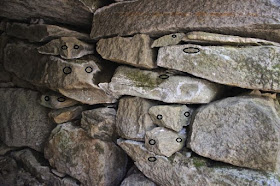by Leigh Macmillen Hayes
Photos and some text
from the blog post: http://wondermyway.com/2016/04/03/wondering-beside-willard-brook/ (and my speculations and photo overlay illustrations)
Leigh writes: "Part of my quest was to take
a look at stone placement and think about it not as Colonial only, but also as
Pre-colonial or Native American...I’ve learned from others to look at the
shapes incorporated into stone walls and fences. I may be making this up
because I’ve had an affinity with turtles since I was a young child and own
quite a collection even to this day, but I see a turtle configured in this
wall. Planned or coincidence? Worth a wonder..."
This is an
Archaeologist joke about finding patterns: “One is an accident, two is a
coincidence, and three is a conspiracy.” I’m assuming that when you find more
than three examples, you might have an established pattern, but that isn’t part
of the joke. I may be remembering it incorrectly but I think there’s a place
called Easter Island where there are rows of more than four big stone bunnies…
So if I look at
the photo above, I see the coincidence of two triangular stones of roughly the
same size with inclusions of what might be quartz about where the eyes of some thing that reminds me of some sort of animal, placed with those eye-like features
uppermost in this stone wall, as if to suggest “intention” of the builder to incorporate an animal, possibly a reptile, maybe specifically a turtle, into this stone wall:
But that’s just
two, so it could be a coincidence – a coincidence that a Euro-American farmer
in Maine, who found he had no trees around anymore at a certain point in time,
resorted to using stones to build a fence and just happened to do this, maybe
by accident or maybe even just joking around.
But you know I
personally can’t help but look for more possible intention placement that might
recall more zoomorphic head stones (and yes, there’s even a suggestion of a
“Healing Diamond” or rhomboidal shaped stone):
And I suppose
because I am finding those rhomboidal stones near the head stones of what I at
least think are (way more than four) snake representations both large and
small, I can’t help but notice this detail:
But am I seeing the
same alleged turtle as Leigh? A turtle representation needs more than just a head to be interpreted as a turtle in any sort of artwork media, so looking for a representation of a shell or carapace, I wonder, "Could it be this one below, composed of three stones - head, shell and foreleg?"
Or this one with some thin marginal scutes above a possible
head, a couple of those other kind of scutes I can’t remember the name of right
this second just above those??
Maybe this one
with a big foot or foreleg, rolling its eyes at me (maybe just like you are) during this sort of ink-blot test?
Over by the
chamber-like structure, farther along Leigh's route of exploration, there’s a bit of the same thing going on, I think.
Leigh writes:
“On the outside of
the chamber’s edge that connects with the cellar–again my imagination took
over. Perhaps my turtle’s head is the large blocky rock bottom center. Or is it
a smaller version in the rocks above. Am I seeing things that are not there? Overthinking
as my guy would suggest?”
I think I can see
what she means, but you know that stone to the left of it looks a little
“worked” to me, as if maybe to represent a nuchal notch along the row of marginal scutes sort of thing and
maybe two turtles above that:
Inside, I see way too many possible eyes for
me to even think coincidence – and just because I’m seeing how different forms
seem to pop out in different light conditions, I’m thinking a stone can be more
than just one thing, all depending on how and when you are viewing it, not
unlike other rock art in the world (a turtle’s shell could also be a snakes
head, just as each segment of a snake might be another snake, all depending on
your perception at a particular moment):
This could be a a simple little petroform placed on a boulder encountered further along Leigh's walk, perhaps,
turtle head, shell and a foreleg, but I wonder
just a little if it changes as you view it from another angle, just because I
can and, after all, we are wonderingmyway:
If I hadn’t been looking at the stone
fence at another Burial Ground of the same time period and finding more
possible Native American Iconography, I might not have noticed a sort of bear’s
head looking stone, just touched a little by the shadow of a tombstone:
I wonder if this might be a Native-made
Causeway, a suggestion of a turtle and a snake as well (a little sugar-loaf
sort of Manitou stone in there too):
And while I’m wondering, I notice the names
in the bottom corner of this map Leigh included:
I wonder: Are there white (quartz?) stone piles
along the White Cairn Trail? Who built a Stone House on Stone House Trail? Is it something other than an actual house or is it an outcrop or rock shelter? Are
there blueberries on Blueberry Ridge and Mountain (with stone fuel breaks that
might resemble the rows of stones at Burnt Hill {http://wakinguponturtleisland.blogspot.com/2014/09/two-on-burning-as-in-burnt-hill.html}in MA?) Rattlesnake Mountain
and Rattlesnake Brook? Real live Rattlers or stone Rattlesnakes or both??
I really do wonder…













No comments:
Post a Comment